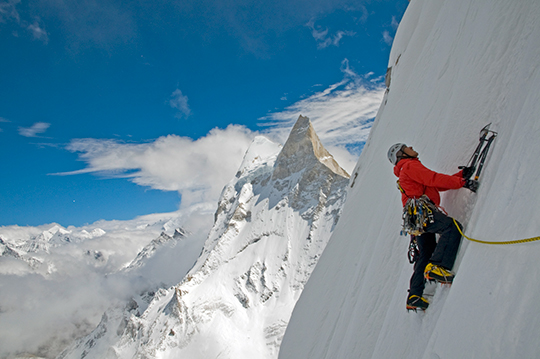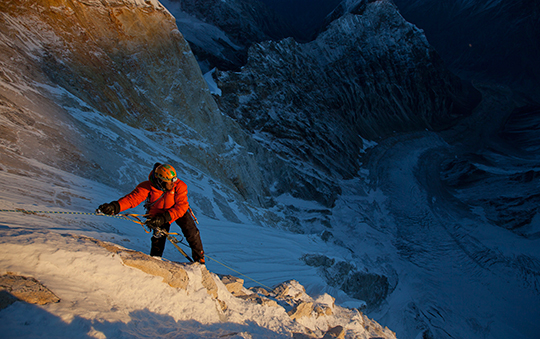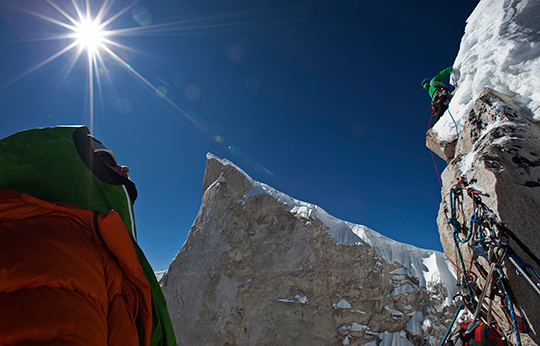
[Photo] Renan Ozturk, courtesy Music Box Films
It’s over and they know it. Conrad Anker, Jimmy Chin and Renan Ozturk are 7,000 miles from home, 20,000 feet above sea level and a mere 300 feet below the summit of Meru Central (6310m), the middle summit of Meru Peak, in India. Surrounded by the skyscraping Garwhal Himalaya, the three men are focused on a 1,500-foot pillar of granite, the unclimbed Shark’s Fin. After 17 days on the wall, their final chance at a summit bid demands an unplanned open bivouac with no portaledge, food or fuel. Frostbitten and weather-beaten, they retreat.
This could be the end of the story. But in Meru, a film scheduled for a limited release by Music Box Films in the U.S. and by Universal Studios internationally on August 14, this is the beginning, and sets the stage for the compelling, 89-minute documentary. Directed by Chin and his wife, filmmaker Elizabeth Chai Vasarhelyi, and shot by Chin and Ozturk, Meru traces the 2008 failed attempt by Chin, Anker (his second, after a 2003 attempt) and Ozturk on the Shark’s Fin and the climbers’ lives after that reluctant defeat, as they wrangle with a persistent impulse to go back.

[Photo] Renan Ozturk, courtesy Music Box Films
Meru is more than just the story of a climbing adventure. Chin–a first-generation American whose parents fled the Chinese Revolution to make a new life in Minnesota–is a highly accomplished professional climber, mountaineer, skier, photographer and director, and one of the elite few to have skied off the summit of Mt. Everest. He and Anker have been climbing partners for more than a decade.
With spectacular first ascents in the Himalaya and Antarctica to his credit, Anker is portrayed as the respected professional climbing veteran we know him to be. An icon in the worldwide climbing community, Anker gained the attention of the general public when he discovered the body of George Mallory on Mt. Everest in 2007. We are reminded of his training under legendary mountaineer Mugs Stump and his long climbing partnership with Alex Lowe. After Lowe was killed in an avalanche on Shishapangma (8027m) in 1999, Anker, who was injured during the slide, and Lowe’s wife, Jenni, found comfort in each other’s company and eventually married.

[Photo] Renan Ozturk, courtesy Music Box Films
And then there’s Ozturk, the wild card. An artist and free soloist, he’s shown soloing Lightning Bolt Cracks (5.11a) on North Six Shooter Peak, a desert tower near Moab, Utah. At home, Ozturk paints oversized mountainscapes and follows a hardcore, low-tech training regimen. Anker recognizes Ozturk’s gifts as a climber and videographer, and takes him under his wing, introducing him to the Himalaya, and to Chin.
Anker’s demons are apparent in close-up interviews interspersed throughout the climbing footage. His lingering survivor’s guilt and heartfelt mourning over the untimely, tragic deaths of his former climbing partner, Lowe, and of his mentor, Stump, are at odds with the risks he is taking in his own life, and the risks taken by his own proteges, Chin and Ozturk, as they join him on Meru.
The low-key manner and humility displayed by Chin, Anker and Ozturk, especially during their down-time on the mountain, lull us into thinking their climbs are perhaps not so serious after all. With lighthearted humor, they crack jokes about the quality of the teetering rock, about the state of their broken portaledge and about their monotonous diet of couscous. However, author and climber Jon Krakauer sets the record straight with commentary laced throughout the documentary. Krakauer tells us, referring to the Shark’s Fin climb, “If they want to stay alive, they cannot fuck up at all.”
After their initial attempt on Meru, Ozturk and Chin team up for more climbs and filming projects, and the story takes a serious turn when each has a close call in separate, life-threatening accidents while filming pro snowboarders in Jackson Hole, Wyoming. Chin is shaken, but Ozturk is broken, and we wonder if he will ever climb again. Both men are forced to reexamine their lives, and to reevaluate their purpose in the world.
After the failed attempt on Meru in 2008, Anker declares the summit “unattainable.” Chin announces, “I’m not coming back,” and Ozturk states the decision to descend was “a relief.” But within hours, fueled by his obsession and with a desire to honor Stump, Anker immediately plans his next attempt. At this point in the film, Chin and Ozturk have met their match on Meru, and Anker cannot sway them to return. But after the pair’s Jackson Hole accidents, they come to the realization that they need to face their fears, and to prove themselves once more. They need this climb.
Throughout the film, we are reminded that these men are willing to take high risks, driven by their trust in each other. These leaps of faith–Chin’s decision to trust Anker and climb with untested partner Ozturk on his first attempt on Meru; Anker’s and Chin’s decision to trust in the damaged Ozturk on the second climb; and finally Anker swapping positions with Chin at the end of the climb–are firmly anchored in a mutual respect shared among the climbers. But each decision to honor those friendships is a pivotal point in the narrative, turning the story in a precarious new direction.
We are caught up in the stories of these men, and caught off-guard when the camera pulls away to reveal a stunning panorama of rock, ice and sky surrounding them. Chin’s and Ozturk’s cinematography dazzles, and we want to hit the rewind button to see that shot, those peaks, again.
Stripped of the dramatic trappings of traditional adventure films, Meru leaves us with the brutal core of big-wall mountaineering. It is a delicate and deadly game of experience and skill, carefully weighed odds and luck. Life-and-death decisions are calculated and made, as the clock ticks and the chances of summiting or even surviving slip away.
Meru tells the story of the honor that exists among people who endure to share a dream, and who dare to live a life unbound.
[Theatrical Trailer]
blog.jimmychin.com